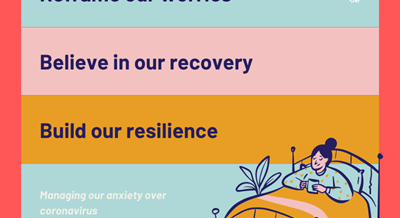
At times of stress, why do we worry ourselves sick? Do men and women differ in the way they experience anxiety disorder? Do our genes determine our future, or do they offer us our best hope of recovery? Professor Jim Lucey explores.
Anxiety is a normal phenomenon.
No species can survive without a warning system which anticipates and helps to respond to hazards and threats. When we are anxious, we become more alert; we prepare and get ready. We anticipate danger. This anticipatory anxiety is associated with increased heart rate, increased breathing and increased sweating.
When do anxiety disorders occur?
Anxiety disorders occur when our anxiety is disproportionate. Anticipation disables us; because of anxiety disorder, we lose the ability to live independently, to work productively or to relate to others socially.
Anxiety symptoms leading to avoidance of situations are called phobias. Unwelcome, intrusive anxiety-provoking ideas thoughts and images are called obsessions; and repetitive behaviours carried out in a ritual fashion in response to stress of obsessive anxiety are called compulsions.
What are the symptoms of panic attacks?
Disabling crescendos of anxiety are called panic attacks. Symptoms of panic attacks include:
- Palpitations
- Pounding heart and chest pain
- Sweating, chills or hot flushes
- Dizziness or light-headedness
- Paraesthesias (shaking or trembling
- Abdominal distress
- Derealization or depersonalization
- Fear of losing control
- Fear of going crazy or dying
- Shortness of breath or smothering/choking feelings.
What are the facts about anxiety disorders?
Anxiety disorders are the most common mental health problems presenting to general practice. They are the most treatable of mental health disorders and none of the treatments requires rare expertise or extremely costly interventions.
is the age of onset of anxiety disorders
of people have occasional panic attacks
is the ratio of women to men living with anxiety disorders
The causes of anxiety disorder are multi-factorial. Childhood trauma is a significant risk factor.
Less than 40% of people with an anxiety disorder receive professional treatment. For anxiety disorders, there is a delay in presentation ranging from nine to 23 years. Along the way, many people with phobic anxiety or panic disorder can become depressed or develop alcoholism.
50% of people living with panic disorder have at least one other anxiety disorder, and 50% develop depressive disorder. Up to 40% of relatives of people with panic disorder develop panic disorder themselves.
Women report more symptoms of panic disorder than men. Women with panic disorder are more likely to experience breathing difficulties and faintness with a panic attack, and they are three times more likely to relapse in the long-term than men.
The majority of women with panic disorder have panic with agoraphobia, whereas men are more likely to have isolated panic disorder. Alcohol misuse is more common in men with panic disorder agoraphobia than in women.
In panic disorder 24% of people will develop a major depression within 5 years and 50% in a lifetime. People with panic disorder are 20 times more likely to die by suicide than the healthy population.
Unfortunately, stigmatic beliefs about people with anxiety disorders are common. These say people with anxiety disorders are just worriers who should pull themselves together. The reality is very different.
What does recovery look like?
Recovery requires brain change; this means new learning, new thinking and new behaviours. The great psychiatrist and Nobel Prize winner, Eric Kandel, teaches us that all recovery involves the person and the brain. This is because all mental processes derive from operations of the brain.
Anxiety symptoms and depression arise from both genetic and environmental factors. Roughly 30% of the contributing factors for the development of anxiety disorder come from genetic pathways, while the remaining factors come from environmental pathways.
Our genes determine the pattern of neuron (brain) interconnections. Learning of functional or dysfunctional behaviours alters gene expression. Gene expression promotes the production of proteins which control our behaviour by building the pattern of brain connections and strengthening them.
Effective psychotherapy changes behaviour through learning; and learning changes gene expression leading to renewed strength of synaptic brain connections.
Our genes have the capacity to facilitate recovery, by making and strengthening the connections our brains need to promote positive behaviours. Far from being a fixed bar code which only limits our hope of recovery, genes are the source of our best hope. All that is necessary is that we learn the recovery behaviours which switch our genes on.
Learn more about anxiety
Author
Prof Jim Lucey
Prof. Jim Lucey was Medical Director of St Patrick’s Mental Health Services, Dublin, from 2008 to 2019. He is Clinical Professor of Psychiatry at Trinity College Dublin. He has been working for more than 30 years with patients suffering from mental health problems. In addition to medical management, he maintains his clinical practice at St Patrick`s, where he specialises in the assessment, diagnosis and management of Obsessive Compulsive Disorder (OCD) and other anxiety disorders. He gives public lectures and is a regular broadcaster on mental health matters on RTÉ radio, featuring on ‘Today with Sean O’Rourke’.
Continue to…
Protecting and enhancing our children’s emotional wellbeing



